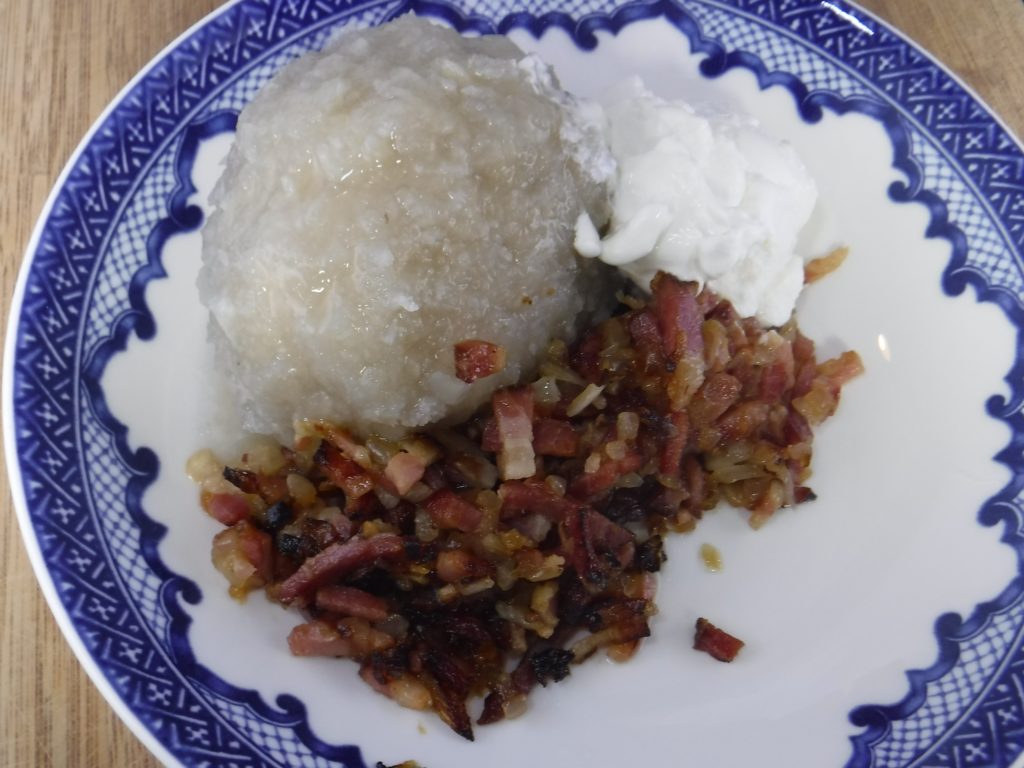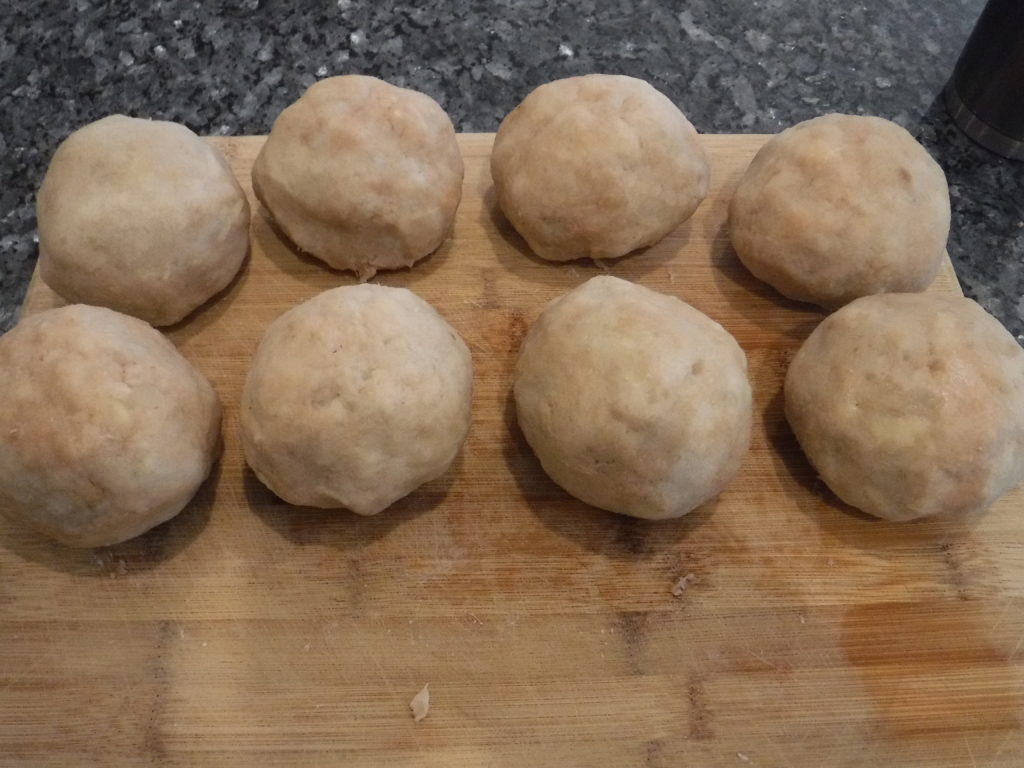
The national dish of Lithuania is a large potato dumpling with a meat center, served with a rich sauce. Most people call these cepelinai (i.e zeppelins) and make them as tapered cylinders, rather like a skinnier version of a football. In Carol’s family, they are called klatskies, which is apparently the Russian word for them, and are shaped as large balls. Carol’s grandmother made them and the sauce in a very particular way, which from a survey of cookbooks, the internet, and a Lithuanian Club in Baltimore is not the way that most people make them.
First of all, most people simplify preparation and lighten the dumpling by including some proportion of boiled and mashed potatoes to the grated raw potatoes. Second most people simplify the sauce to sautéed bacon and onion (called in Lithuanian spirgučiai) with sour cream on the side. In Carol’s family, the sauce made from butter, cream, onions, and bacon.
Amanda and I decided to see if we could move the family Klatsky preparation from the pre-WWI Russian Empire to the 21st century. We decided to base our approach on the Cepelinai recipe in My Food Odyssey Lithuanian Cooking by June Molloy Vladička. We used some very good quality home-made cottage bacon and used about twice as much of the sautéed bacon and onions per person as in her recipe. It is hard to have too much bacon and onion.
Our dumplings were a success. They held together and were a little lighter than usual (which Carol thought was a negative – not the taste of her childhood! I think the next time, I will squeeze the grated potatoes just a little more, and I will cook more bacon and onions. We served this for dinner with Lithuanian Cold Beet Soup (Saltibarsciai)
For the potato dough
3 kg. (6 lbs. 9 oz.) Russet potatoes, divided
Citric acid or Vitamin C
2 Tbs. potato starch or corn starch (for the water for boiling the dumplings), plus additional for the dough as needed
For the meat filling
500 g. (1 lb. 2 oz.) ground pork
1 tsp. salt
½ tsp. garlic powder
2 Tbs. cold water
For the topping
250 g. (9 oz.) good quality bacon, diced
400 g. (14 oz.) onions, chopped
Sour cream
Peel the potatoes, putting them in a bowl of cold water to prevent them from turning brown. Cut up 500 g. (1 lb. 2 oz.) of the potatoes and boil them until cooked. Drain, mash, and reserve. (Do not add butter or milk. We are not making mashed potatoes.)
Heat a large pot of water on the stove. Ideally, this is a wide pot big enough for 8 baseball sized dumplings to cook in a single layer without touching each other.
Finely grate the remaining potatoes into a bowl, using either the fine side of a standard grater or a potato grater, which is more like a paddle with a web of heavy wires. Add a little bit of citric acid (try ½ tsp.) or a ground up Vitamin C tablet to the grated potatoes to prevent discoloration. When the potatoes are all grated. Squeeze them as dry as possible using butter muslin or a clean dishtowel, and put the squeezed potato into another bowl. Reserve the water. After the water has settled for a while, pour it into another bowl, and add the starch which has deposited on the bottom of the bowl into the squeezed potato. Add the mashed potato. Mix together the squeezed potato, potato starch, and mashed potato into a dough, which should be the consistency of play dough. If it is too wet, add some potato starch. If it is too dry, add some of the potato water. Getting the right consistency is key to having a dumpling which will hold together and not crack. Divide the dough into 8 portions
In another bowl, mix together the ingredients for the meat filling and divide it into 8 meatballs.
Put each portion of the dough on your hand into a circle. Place a meatball in the middle of the dough and fold the dough over the meatball so that you have a smooth ball with no cracks. Repeat with the other 7 pieces of dough and meatballs. Here is what the dumplings look like when they are ready to cook:

In a bowl mix together the 2 Tbs. of potato starch or cornstarch with a cup of cold water.
When the large pot of water has been brought to a boil, reduce it to a very gentle simmer. Stir in the potato/corn starch slurry and then carefully add the dumplings, and cook them for 45 minutes. They will initially sink to the bottom of the pan and will rise when they are cooked. After a few minutes, pass under them with a spoon to ensure that they are not sticking to the bottom of the pan.
While the dumplings are cooking, make the sauce. Sauté the bacon in a large skillet. When the bacon has released some grease, add the onions and cook them together over medium heat until the bacon has crisped and the onion is soft.
When the dumplings are done, remove them from the water. Serve each dumpling with the bacon and onion and with a healthy dollop of sour cream. Enjoy!


It was delightful to see this recipe and to learn that klatsky is the Russian term. My memory of these is that the meatball was a mixture of beef, veal and pork. I will definitely try this recipe with the mashed potatoes!
Klatskies, I think, is actually derived from Polish. The analogous Polish dish is called pyzy. In any event, I’ve never heard them called this, but so many things got mangled in the New World. One trick my MIL taught me – put the potatoes (the raw ones) through a juicer – some juicers reduce them to a paste, but most of them retain some texture. The pulp will be as dry as you can possibly desire. If you are making potato pancakes or kugelis, you can add some of the liquid back. Be sure to let the juice stand so that the potato startch would settle out and add that back to the dish. I enjoy your site.
My grandmother who was a Lithuanian called them klatskies also. I don’t remember potatoes in them but I do remember a white sauce and a brown-light red sauce that she served them in. Having said that, her family recipe has been lost for some time and I have been looking for another. I am 57 years old now and the last time I had these was when I was about 12 years old. Thank you for the recipe, I will try and make these both ways, with potatoes and the way my grandmother made them without potatoes.
My wife’s grandmother was from Karklena (or Karklenai as an alternate spelling) in north-central Lithuania. Maybe Klatskies is a regional term. They were great favorites of my wife’s father. His sister, my wife’s aunt made them with wheat flour instead of potatoes, I think because she found that was easier to do. Good luck!
Wow! Thank you for this recipe. I was always told “klatskies” as well by my Lithuanian grandmother. She made them in a flatter shape and with whatever meat she had available. Usually pork or beef. Best part, is that I hated them as a child and she passed when I was young. I can still very clearly taste them and have been craving them for 20+ years.
I also grew up with them being called Klatskies. My father’s relatives were probably from North Central Lithuania as well. I’ve only known them with flour, no potatoes, no sauce, and only sour cream. Thank you for this site.